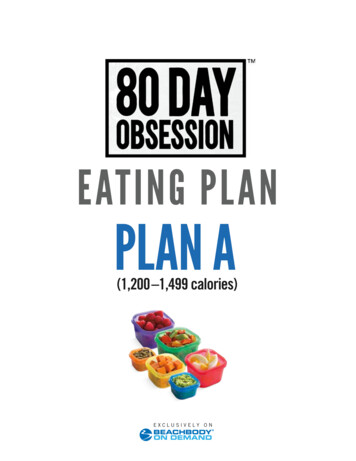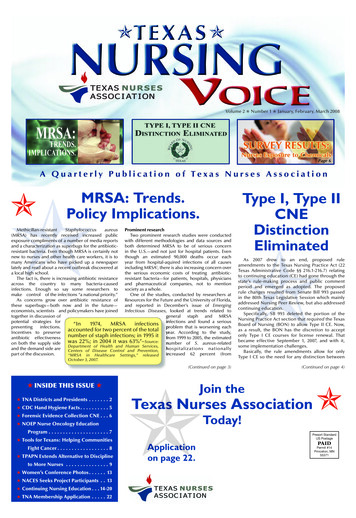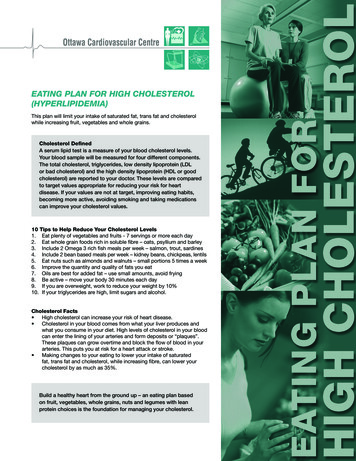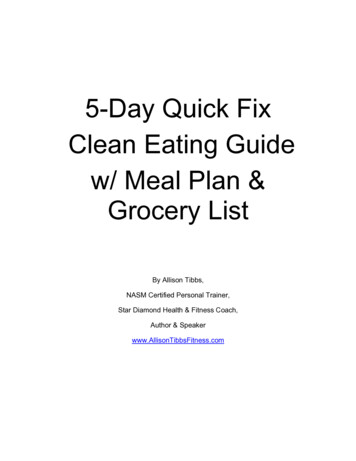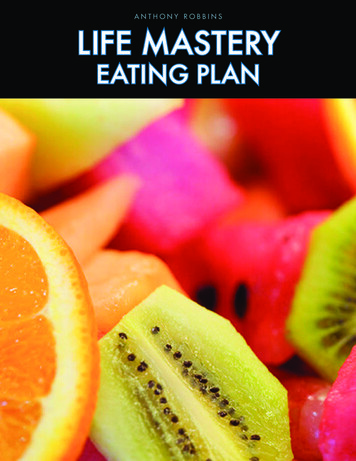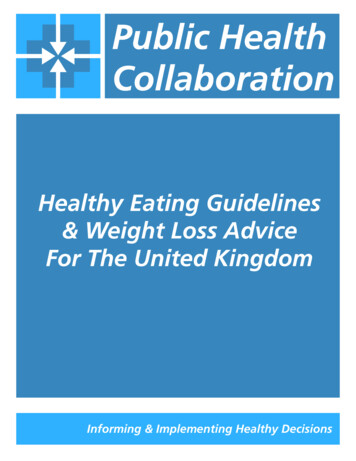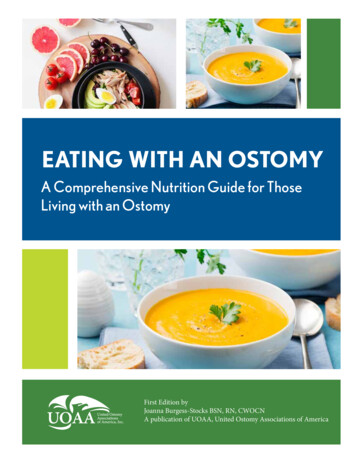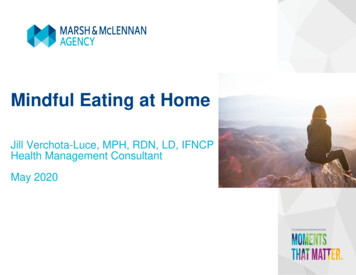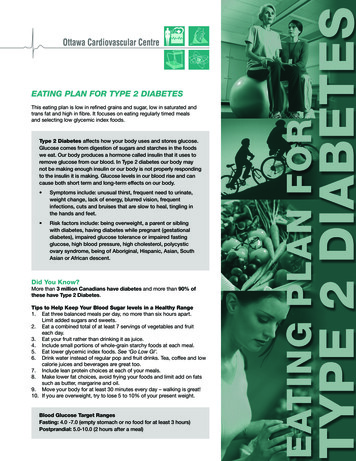
Transcription
EATING PLAN FOR TYPE 2 DIABETESThis eating plan is low in refined grains and sugar, low in saturated andtrans fat and high in fibre. It focuses on eating regularly timed mealsand selecting low glycemic index foods.Type 2 Diabetes affects how your body uses and stores glucose.Glucose comes from digestion of sugars and starches in the foodswe eat. Our body produces a hormone called insulin that it uses toremove glucose from our blood. In Type 2 diabetes our body maynot be making enough insulin or our body is not properly respondingto the insulin it is making. Glucose levels in our blood rise and cancause both short term and long-term effects on our body. Symptoms include: unusual thirst, frequent need to urinate,weight change, lack of energy, blurred vision, frequentinfections, cuts and bruises that are slow to heal, tingling inthe hands and feet. Risk factors include: being overweight, a parent or siblingwith diabetes, having diabetes while pregnant (gestationaldiabetes), impaired glucose tolerance or impaired fastingglucose, high blood pressure, high cholesterol, polycysticovary syndrome, being of Aboriginal, Hispanic, Asian, SouthAsian or African descent.Did You Know?More than 3 million Canadians have diabetes and more than 90% ofthese have Type 2 Diabetes.Tips to Help Keep Your Blood Sugar levels in a Healthy Range1. Eat three balanced meals per day, no more than six hours apart.Limit added sugars and sweets.2. Eat a combined total of at least 7 servings of vegetables and fruiteach day.3. Eat your fruit rather than drinking it as juice.4. Include small portions of whole-grain starchy foods at each meal.5. Eat lower glycemic index foods. See ‘Go Low GI’.6. Drink water instead of regular pop and fruit drinks. Tea, coffee and lowcalorie juices and beverages are great too.7. Include lean protein choices at each of your meals.8. Make lower fat choices, avoid frying your foods and limit add on fatssuch as butter, margarine and oil.9. Move your body for at least 30 minutes every day – walking is great!10. If you are overweight, try to lose 5 to 10% of your present weight.Blood Glucose Target RangesFasting: 4.0 -7.0 (empty stomach or no food for at least 3 hours)Postprandial: 5.0-10.0 (2 hours after a meal)
Type 2 Diabetes FACTS – Focus on Carboyhdrate, Fibre and Glycemic Index Over time, high blood sugar causes damage to your blood vessels and can result in blindness, heart disease, kidneyproblems, circulation problems, nerve damage and erectile dysfunction.By choosing appropriate portions of carboydrate containing foods and selecting ones that have more fibre and a lowerglycemic index, you help improve you blood glucose control.Go Low GI – Foods and Their Glycemic IndexGlycemic index is a scale (0-100) ranking how quickly a carbohydrate containing food will digest into glucose in our blood. HighGI foods break down quickly whereas low GI foods break down slowly. With low GI foods you feel full longer and you body’sinsulin has more time to perform its job and remove glucose from the blood.Hint: Hint low GI foods are generally ‘close to the farm.’LOW GI FOODS (55 OR LESS)CHOOSE MOST OFTENMEDIUM GI FOODS (56-69)HIGH GI FOODS (70 )CHOOSE LESS OFTENWhole grain breadCouscousWhite breadPumpernickle breadRye breadInstant mashed potatoesOatmealInstant OatmealCorn Flakes, Rice KrispiesAll-Bran cerealShredded WheatRefined, sweetened cerealsConverted riceCream of WheatInstant riceBrown & Basmati riceWhole grain crackersBagelsBulgur, Barley, QuinoaPita breadWaffles/pancakes – made with whiteflourFirm cooked pastaLong grain white riceSoda crackersBeans, peas, lentilsApricot, bananaFrench friesApples, peaches, pearsCantaloupeDried dates/figsGrapefruit, orangesPineapple, raisinsSweetened fruit juiceBerries, cherries, grapesCanned fruit in juiceParsnips, pumpkinKiwi, Mango, PlumCranberry juiceRutabaga, turnipAvocadoNew potatoesBroad beansSweet PotatoBeetsRefried beansCarrots, broccoliSweetened condensed milkIce creamCauliflower, cornSoft drinksLeafy vegetablesGlucoseLow fat milk, soymilk, yogurtand cottage cheese*Adapted from “The GI Diet” Rick GallopTips for using the Glycemic Index Think low and slow - choose from the low and medium GI foods most often.Balance your choices with lean protein choices and healthy fats. Protein and fat also slow the digestion, keep you feelingfull and slow the release of glucose into your blood.More details can be found online at www.gidiet.com or www.diabetes.ca/files/glycemicindex 08.pdfDid you know?The Glycemic Index diet was developed by David Jenkins, a professor of nutrition and reasearcher at the University of Toronto.
Balancing Carbohydrates (‘Carbs’)Along with the glycemic index approach, it is important to understand and control the amount of carbohydrates you eat and drinkto better manage your blood glucose.Here are some tips:1. Carbohydrate is the nutrition term used for starch, sugar and fibre.2. Spacing your carbohydrates over the day helps your body to keep a stable glucose level.3. Starch choices that are higher in fibre contribute less to raising your blood glucose. Use the Nutrition Facts panel to choosecereal, bread, crackers, rice and other grain or starch choices that have at least 2 grams of fibre per serving.4. Breakfast should be 1/3 starch or grain, 1/3 fruit and 1/3 protein.5. Lunch and supper should be 1/2 vegetables, 1/4 starch and 1/4 protein.6. Snack choices can help prevent dips in blood glucose that can occur if your meals are more than 4 hours apart or if you arevery active.7. Choose snacks with about 20 grams of carbohydrate. Fruit, vegetables, high fibre granola bars, whole grain crackers withcheese or peanut butter are just a few options.Sugar and Refined Starches See it to Believe it!Table sugar, brown sugar, honey, maple syrup and molassesare all simple sugars and they all have 5 grams of carbohydrates1 tsp 5 grams sugaror “carbs” in a teaspoon.Simple sugars such as these and ‘white’ or refined starches breakdown quickly and cause blood glucose to rise quickly.A quick rise in blood glucose can often be followed by an equally quick drop.This can lead to cravings for more sugary foods and feelings of hunger and fatigue.Aim to choose packaged foods with less than 10 grams of sugar per servingAvoid adding sugar, reduce the amount or substitute a non-sugar sweetener for baking such as Splenda (sucralose)The Canadian Diabetes Association has an excellent summary sheet on sugars and sweetners.Find it on line at www.diabetes.ca/files/en sweeteners final.pdf or call 1-800-BANTING to request a copy.Did you know?A standard can of regular pop contains the equivalent of 10 tsp of sugar and a 2L bottle of pop has 1½ cups of sugar!Water is the best beverage for quenching your thirst.Decoding Food LabelsThe Nutrition Facts table found on the side of packaged food can help you make better food choices. Always check the servingsize first and consider this in relation to how much of the food you usually eat.Look for choices with less fat, saturated fat, cholesterol and sodium. Look for choicesthat give you more fibre.Learn more about using food labels to make healthy choices on the web:Health Canada – /index-eng.phpHealthy Eating Is In Store for You – www.healthyeatingisinstore.caDid you know?Fibre is a carbohydrate that does not raise blood sugar. Using the Nutrition Facts, you can subtract the grams of Fibre fromthe grams of Carbohydrate. Only count the remaining carbohydrate toward your meal plan.
Portions to Live By ne serving of whole grains is 1/2 cup cooked, not theO3 or more cups served in most restaurants! Too much ofa good thing is not a good thing.For more details on healthy portions seeEating Well with Canada’s Food Guideonline at tarchFruitLunch & SupperProteinStarchVegetablesHow Many carbs are right for me? Carbs are one of the energy nutrients. We all have diferent energy needs based on our activities, age, gender, goalsto maintain or lose weight just to name a few.In general, most adults need 45 to 60 grams of carbohydrates per meal.Using food labels will help you to choose foods to provide about this amount of carbohydrate per meal.To plan your meal you should know that in each of the following foods there are about 15 grams of carbs:–– 1slice of bread (the size of a CD case)–– ½ cup of cereal–– 1 piece of fruit (the size of a tennis ball)–– 1 cup of low fat milkVegetables are very low in carbs and are often considered ‘free’ – load up!Exchange lists indicating the portions of food to provide 15 grams of carbohydrate are available. Ask a registereddietitian for more details.If you are using insulin to control your blood sugars, you may want to learn more about balancing your carbohydrateswith an approach called Carbohydrate Counting. Ask to speak with a registered dietitian.Fibre When reading food labels look for foods higher in fibre.Bread choices should have at least 2 grams per slice. Cereal choices should be 4 grams or more per serving.Grandually increase your fibre intake and aim for 30 grams each day.Fibre is a carb that does not digest. When reading the Nutrition Facts table, subtract the fibre grams from the totalgrams of carbs to determine the carbs that contribute to your meal.To Reduce WeightIf you are overweight a gradual reduction of 5-10% of your initial weight can inprove blood glucose control. Suggestionsinclude: Eat smaller portions of foods and remember the balance of foods on your plate: 1/4 protein, 1/4 starch (includingpotatoes), 1/2 vegetables for lunch and supper Eat 3 meals per day, no more than 6 hours apart. Don’t skip meals. Snack with fruit between meals. Choose foods lower in fat and sugar. Eating strategies including low glycemic index choices can be helpful. Learnmore from a registered dietitian. Aim for a maximum weight loss of 1- 2 lbs (0.5 -1 kg) per week.“Waist loss” is as important as weight loss. For tips on how to trim your waist see our ‘Waisting Away – HealthyWeight Management’ nutrition fact sheet.Staying Healthy with DiabetesBeing overweight or obese makes your body more insulin resistant. This makes controlling blood sugars morechallenging. Excess weight and diabetes are both risks factors for heart disease.For more details on Weight Management, Cholesterol or Hypertension see: Eating Plan for Hypertension, EatingPlan for High Cholesterol and Waisting Away - Healthy Weight Management. All are available from the OttawaCardiovascular Centre website. Go to www.ottawacvcentre.com.
Type 2 Diabetes Eating PlanChoose Low Glycemic Index Foods Whenever Possible!FOODS TO CHOOSEWhole Grains Whole and multi grain breads, whole wheat pasta,brown rice Low-fat and multigrain crackers Low-sugar, whole-grain cereals Oatmeal, bran, bulgur, buckwheat Low-fat, whole grain baked goods with added branor oat branFOODS TO LIMIT OR AVOID White breads, croissants, sweet rolls, high-fat whitecrackers, wafflesShort-grain and minute rice – white riceSweetened refined cerealsCommercial muffins, cakes, doughnuts, Danishpastries, high-fat cookiesAvoid “white” foods (white flour, white sugar)Vegetables and Fruit – with lots of colour Dark green leafy vegetables Eat an abundance fresh/frozen vegetables Unsweetened, fresh, frozen or canned fruits Parsnip, pumpkin, white potatoes (high GI)Dried fruits and fruits in heavy syrupSweetened fruit juicesMilk and Alternatives Dairy products with less than 1% fat Cheese should be 10-20% MF Milk products higher than 1% fatCheese higher than 21% MF and creams Fish with butter or breadingFried chicken, poultry with skin, wingsFatty marbled meats, ribs, regular ground meats,organ meatsHigh fat processed and canned meats: bacon,sausages, patés, bologna, salami, wienersMeat and Alternatives Fish (canned in water, fresh, frozen), seafood Skinless chicken and turkey Lean meats with fat trimmed, wild game Lean cold cuts (but watch the salt content) Legumes, tofu Eggs (up to eight per week)Meat and Alternatives Olive, canola, soybean, sesame, sunflower oils (3 tsp or less per day) Non-hydrogenated soft margarinesLow-caloriedressings and mayonnaise Light peanut butter, nuts (watch salt and calories) Unsalted seeds: flax, pumpkin, sunflower Defatted gravy and low-sugar condiments Cocoa powder or a small piece of dark chocolateSweets (in very small amounts) Sugar substitutes and artificial sweeteners, low sugarjams/jellies/syrups Sugar-free candies, gelatins, gum Low-sugar and high fiber baked goods Low-fat and low-sugar frozen dessertSnack Foods Popcorn without salt, butter, or hydrogenated oils Choose low fat, low sugar snack foods Hydrogenated oils, coconut and palm oilsShortening, butter, lard, hard margarinesPeanut butter with palm or hydrogenated fatNo more than 1/4 cup nuts per day (high calories)Heavy gravy, cream sauces, high-sugar condimentsChocolate and carob Sugar and regular jams, jellies, syrups, candies,gelatins, gum, honeyRegular cakes, pies, cookiesNo “white” foods (white flour, white sugar)Regular frozen desserts Regular popcorn, chips, pretzels, cheesies, corn chips
Alcohol Limit alcohol to less than 2 drinks per day (1 drink 12 oz beer or 1.5 oz liquor or 4 oz wine)Alcohol is not recommended if you:–– have high triglycerides (type of blood fat)–– have liver problems–– are pregnant or breastfeedingIf you choose to drink alcohol, remember:–– To drink with your meal or snack (not on an empty stomach)–– To drink slowly or dilute with water or diet soda–– That liqueurs, sweet wines and dessert wines have more sugar–– To wear your MedicAlert indicating that you have diabetes – alcohol can cause a low blood sugar reaction which,if left untreated, may require medical attentionSupplementsCheck with your Doctor, Dietitian or Pharmacist before starting a supplement. Heart Healthy Mixture 1/3 ground flax, 1/3 oat bran and 1/3 psyllium. Use 2 Tablespoons per day added to foo
EATING PLAN FOR TYPE 2 DIABETES This eating plan is low in refined grains and sugar, low in saturated and trans fat and high in fibre. It focuses on eating regularly timed meals and selecting low glycemic index foods. Type 2 Diabetes affects how your body uses and stores glucose. Glucose comes from digestion of sugars and starches in the foods we eat. Our body produces a hormone called File Size: 2MBPage Count: 6
